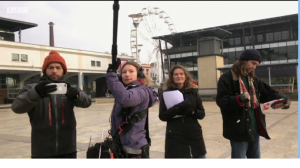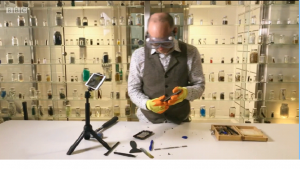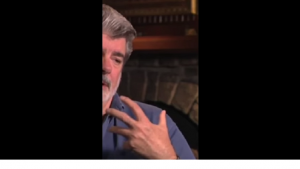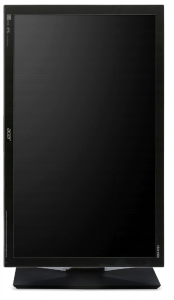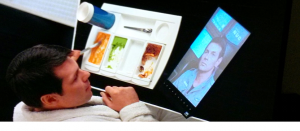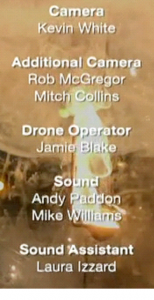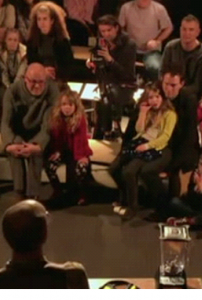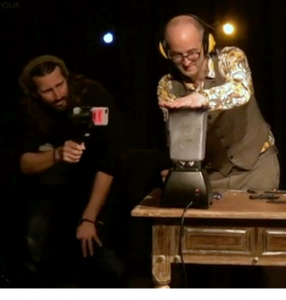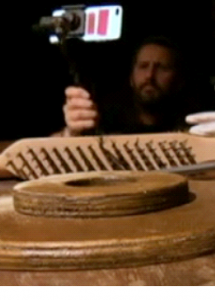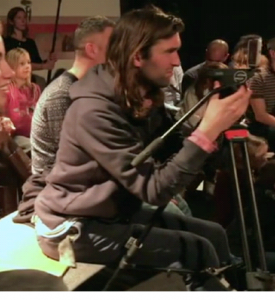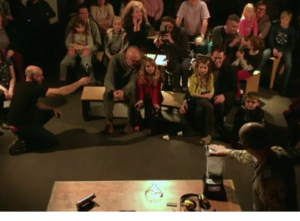Keith Wicks
Some people criticised London Live’s use of cheap equipment. Well, the BBC now seems to be competing.
This is interesting — "a first for BBC4" — a documentary "filmed" entirely on Smartphones.
It was broadcast on 24th May 2017 at 9pm: “Secrets of the Super Elements”. You have been warned! I know they have to cut costs, but this seems a little extreme.
(Click on the pictures below to see larger versions:
use your Browser’s BACK button to return to this page)
Nick Ware
I wonder if this is the start of a secret manufacturer-led conspiracy in cahoots with programme makers and Apple et al, to persuade us all to buy ‘upright’ format TVs? Now that we’ve all got all the flat screen TV’s we want, and 3D fell flat on its face, they must be looking for a new market-push!
Or to put it another way, why do so many people shooting pics or video on mobile phones insist on holding them upright?
Or to put it another way, why don’t phone manufacturers design their (already near enough 16×9) phones so that horizontal is the natural and obvious way to use them?
Geoff Fletcher
I’ve never understood the upright usage either. It’s just so unnatural – our eyes aren’t set one above the other, after all!
Dave Plowman
Because they are stupid?
Peter Neill
Any excuse to share this:
https://www.youtube.com/watch?v=Bt9zSfinwFA
Say “NO!” to Vertical Video:
(Click on the picture below to see larger version:
use your Browser’s BACK button to return to this page)
Vertical Video Syndrome!
Bill Jenkin
Of course it’s just as "natural" to use a "golden ratio" frame upright or horizontal. In stills photography or art you choose portrait or landscape. The problem comes when you shoot one way round and exhibit it on a device which only shows the other.
Geoff Fletcher
I agree with the comments as applied to still photography of course.
However, I don’t think it applies to moving pictures – the vertical format just seems so unnatural and doesn’t fit the with the normal human visual field of view. I’m sitting in my parked car right now, and looking straight ahead, I can see both wing mirrors at the edge of my natural "frame". This is much more in line with the view of a horizontally held mobile phone camera. The vertical view just grates on me I’m afraid.
Dudley Darby
But our ears and mouth aren’t at the same level, at least not for most people, and it is called a phone after all….
One brick that does everything just isn’t the perfect answer.
Geoff Fletcher
Yes that’s true – it isn’t a mobile camera with a built in phone, after all. However, I still think it is as easy to hold horizontally as it is vertically just to capture movies.
Graeme Wall
Re Vertical Video: Please forward to BBC News!
Peter Neill
It’s not the BBC’s fault.
When viewers used camcorders and sent their footage in on tape, there was no problem. Unfortunately when they shoot on their phones, it’s wrong for telly. There’s very little we can do. If we zoom in to fill the frame, the quality is appalling and most of the action is lost. To add to the problems, phones record at 30fps without the use of an app to change the frame rate.
Facebook is perpetuating the situation – its Facebook Live mode expects the camera to be held vertically – if you turn it on its side it comes out wrong.
I fear that the battle is already lost. Increasingly footage shot on a phone is viewed on a phone or tablet, and even if viewed on a computer, you’re watching it in a window and don’t bother with the fact that it’s not filling the screen.
Some years ago Apple produced a vertical monitor for use with word processors – so that a sheet of A4 (or US Legal) paper would fill the screen in portrait mode.
It didn’t catch on.
Ian Norman
I recently bought a monitor for my PC and one of its features is the ability to easily rotate it to portrait mode.
Of course, I don’t use it like that, but maybe this is the shape of things to come.
(Click on the picture below to see larger version:
use your Browser’s BACK button to return to this page)
Pat Heigham
I saw a Fuji screen, years ago that would rotate between portrait and landscape – ideal for secretaries typing letters, I thought.
Most tablets will re-arrange the display aspect ratio when one turns the thing through 90 degrees.
John Howell
About 25 years ago, the ‘Radius Full Page Display’ had this feature.
Alasdair Lawrance
We went to see B. Springsteen at The Ricoh in Coventry and they had two very big monitors each side, one horizontal, one vertical. They had different cameras feeding them, and the operators were either told which monitor they were feeding or had the correct mask in the viewfinder. It worked very well.
Graeme Wall
After the Westminster attack, one BBC journalist held in one of the cordoned off areas sent in a PTC shot on her own mobile phone, good initiative, but she held the thing vertically!
Peter Neill
Interesting, because the BBC app, which is linked to the BBC news server system, won’t let you shoot vertically.
Graeme Wall
Possibly not her phone or she didn’t have the app loaded?
Pat Heigham
Now, what about an app which smoothes out ‘wobblycam’? Must have a professional version, please!
Peter Neill
Not an app – but the journalist who uses a phone to shoot stories for online here in Cambridge uses a handheld gimbal mount. And I have an app on my phone which formats the shot to landscape no matter what angle you hold the thing. It’s called Horizon, if you’re interested.
Roger Bunce
I blame Stanley Kubrick. There were portrait format TV screens (displaying Kenneth Kendal), aboard Discovery One, in “2001:A Space Odyssey”, set at a jaunty angle into a horizontal table-top.
I am reminded of a Punch cartoon, which depicted a tall, office-block type building, labelled ‘National Portrait Gallery’, beside a long, low building, labelled, ‘National Landscape Gallery’.
(Click on the picture below to see larger version:
use your Browser’s BACK button to return to this page)
and back to the programme …
Tony Crake
Well wasn’t the “Secrets of the Super Elements” interesting?
I suppose it shows that if something grips your interest it doesn’t matter what its made on. Sound wise there were little pieces of distant sound that might have come off a "real iPhone", but listening on cans, as I was, the track was mainly created by the sound lady waving her ‘fishing rod’, and good it was too…!
The subject matter and the slightly quirky presenter guy rather gripped my attention and the actual pictures seemed very sharp and we had none of the dreaded "portrait’ mode so avidly discussed… I am almost tempted to say "lets have more of it".
However why is the stuff that IS shown on News, Current affairs and BBC South… SO bad then ?
Philip Tyler
I too was gripped by the subject matter and thought it was an excellent programme.
The only real give away was noise in the lower light shots.
It really helped that the sound was done ‘professionally’: if it had been iPhone sound I think my attention would have waned very quickly.
Just goes to prove how important sound is.
Keith Wicks
I agree. I thought I noticed a couple of minor problems, but I was looking for technical trouble, rather than just watching the programme normally. The main thing is that, had I not known in advance, it wouldn’t have crossed my mind that there was anything unusual in the way this programme had been made — except at the end, when some shots included pictures of technical personnel.
I think that mobile phone stuff shown on News and other programmes is so bad because they are usually spur-of-the-moment recordings, rather than carefully planned takes by experienced camera operators. Also, news items provided by the public are generally handheld whereas, for much of yesterday’s programme, the Smartphones were tripod mounted. Below are the credits for the “Secrets of the Super Elements” programme, together with some shots showing camera and sound personnel and equipment.
(Click on the pictures below to see larger versions:
use your Browser’s BACK button to return to this page)
John Howell
I’ve just watched it on iPlayer to see what all the fuss was about and yes, so interesting that I soon gave up looking at the production technicalities.
What joy, a programme that didn’t keep repeating what was ‘coming up later’ or telling me not to ‘go away’. The topics flowed smoothly from one super element to the next, oh, and I think I noticed some music from time-to-time. The presenter was ‘slightly quirky’ as you say but his delivery was consistent and easy to listen to and the quality of the voice-overs matched that of the in-vision sequences pretty well.
Laura Mulholland’s blog is worth reading.
“… We decided on iPhone 7 Plus because it has two built-in lenses, a massive 256GB storage capacity, impressive battery life and waterproof handset – useful when filming outdoors in winter. The Filmic Pro app was vital for manual control of focus, exposure and converting the phone’s native 30fps (frames per second) to 25fps, as required for UK broadcast….”
John Howell
I thought Curved Screens were the latest fad, ‘for the immersive experience’: that won’t work for an ‘upright’ format! I suppose you could curve them vertically like telephone handsets used to be. It would limit the scope of a two-shot if the number of over-weight people is to be believed.


